
Dec . 12, 2024 09:31
Back to list
gasifier
Understanding Gasifiers A Deep Dive into Gasification Technology
Gasification is a technological process that converts organic or fossil-based materials into carbon monoxide, hydrogen, and carbon dioxide. Through this process, materials such as coal, biomass, or even municipal solid waste are transformed into a synthesis gas (syngas) that can be utilized for various applications, ranging from electricity generation to producing fuels and chemicals. As the world increasingly seeks sustainable and efficient energy solutions, gasifiers have gained prominence as a viable option.
At its core, a gasifier operates by heating organic materials in a low-oxygen environment, a process that initiates pyrolysis—the thermal decomposition of materials in the absence of oxygen. During pyrolysis, large molecules break down into smaller compounds, resulting in solid char, liquid tar, and gaseous components. The subsequent oxidation and reduction reactions take place in the gasifier, producing syngas. The versatility of gasification lies in its ability to process a wide range of feedstocks, including agricultural residues, forestry wastes, and even industrial by-products.
The Components of a Gasifier
A typical gasifier consists of several key components
. The feedstock is introduced into the reactor, often referred to as the gasification chamber. Here, temperatures can reach between 700 and 1,500 degrees Celsius. The gasification process is typically divided into four main stages drying, pyrolysis, combustion, and reduction.1. Drying The moisture content of the feedstock is decreased, which is essential for efficient gasification. 2. Pyrolysis Organic material decomposes in the absence of oxygen, producing volatile gases, bio-oil, and solid char. 3. Combustion A small amount of oxygen is introduced to burn a portion of the char, generating heat needed to sustain the process. 4. Reduction The remaining char reacts with steam and carbon dioxide to produce syngas.
The resulting syngas primarily contains hydrogen, carbon monoxide, and varying amounts of carbon dioxide. This syngas can be further processed or utilized directly in engines or turbines for power generation.
Advantages and Applications of Gasification
gasifier

Gasification technology offers numerous advantages, making it an appealing option for energy production
1. Flexibility in Feedstock Gasifiers can handle a variety of feedstocks, which helps manage waste and promotes resource efficiency. 2. Lower Emissions Compared to conventional fossil fuel combustion, gasification produces fewer harmful emissions, including sulfur oxides (SOx) and nitrogen oxides (NOx), making it a cleaner energy solution.
3. Energy Recovery The syngas produced can be converted into chemicals, liquid fuels, or electricity, maximizing energy recovery and providing versatility in its applications.
4. Carbon Capture Potential Gasification allows for easier integration with carbon capture and storage (CCS) technologies, reducing the overall carbon footprint of energy production.
Challenges Facing Gasification
Despite its advantages, gasification technology does face challenges. The initial capital investment for gasifier systems can be significant. Additionally, the operational complexities and the need for skilled management can deter some potential users. Moreover, maintaining the stability of the syngas production process can be impacted by variations in feedstock quality and composition.
Conclusion
Gasification remains a compelling solution in the quest for cleaner energy alternatives. Its capacity to transform a wide array of feedstocks into valuable energy products positions it as a key player in the future of energy production. As advancements in technology continue to address existing challenges, gasifiers are likely to play an increasingly vital role in the global transition towards sustainable energy systems. Embracing this innovative technology could lead to more efficient waste management, enhanced energy security, and a substantial reduction in greenhouse gas emissions. With the world pressing for a sustainable future, the role of gasification is only set to expand.
Latest news
-
Safety Valve Spring-Loaded Design Overpressure ProtectionNewsJul.25,2025
-
Precision Voltage Regulator AC5 Accuracy Grade PerformanceNewsJul.25,2025
-
Natural Gas Pressure Regulating Skid Industrial Pipeline ApplicationsNewsJul.25,2025
-
Natural Gas Filter Stainless Steel Mesh Element DesignNewsJul.25,2025
-
Gas Pressure Regulator Valve Direct-Acting Spring-Loaded DesignNewsJul.25,2025
-
Decompression Equipment Multi-Stage Heat Exchange System DesignNewsJul.25,2025

